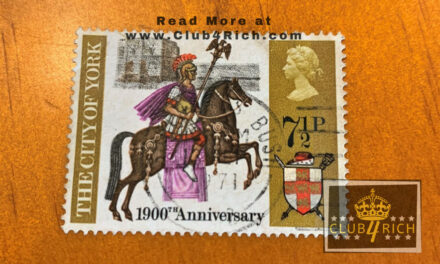Let’s roll on, by defining what we mean by rare Stamps, Coins or Banknotes.
What is a Rare Stamps, Coins or Banknote Collection?
Collecting rare stamps, coins, or banknote has been a popular hobby of investors for generations.
A person who collects stamps is called as Philatelist whereas, collector of coins or bank not is termed as Numismatist.
Their passion for investment in stamps, coins and banknotes are often seen as a way to diversify from equities, mostly in uncertainty.
Highly Expensive Rare Stamps, Coins or Bank Notes in the World
Some of the most valuable and rare stamps in the world are below.
- British Guiana 1c magenta
- Inverted Jenny
- British Penny Red
- 1-Cent Z grill
- Mauritius Post office and
- Treskilling Yellow
Then, here are the top 10 rare coins or banknotes in the world.
- US Red Seal $1,000 bill
- Liberty Head nickel
- Silver dollar Class I
- C$1m coin
- Edward III florin
- Brasher Doubloon
- Saint-Gaudens double eagle
- Double eagle, and
- Flowing hair silver/copper dollar.
However, the reason being of their popularity is mostly the rarity, quality, historical background and printing errors which make them valuable than their face value.
Now the question is if you inherited a valuable collection, then how to care for it and protect it.
How Important is to Insure Your Collectibles?
Many people don’t know how effortless and affordable it is to insure their collectibles. Within a matter of days, this process can be fully build-up.
In addition, the insurance would be possible while saving collectibles such as coins at a bank or home. Just you have to tell your insurer which coverage would you like to have. Then you broker or agent will quote different rates according to a different level of insurance.
Once you bought the policy, then it would be very convenient to increase the limit as you acquire more collectable. It is better to have security at the cheapest rate rather than keeping your valuable assent under your bed.
Now the question is what to consider before insuring your collection?
Insuring your collection is as important as insuring any other valuable thing in your possession.
What To Consider Before Insuring Your Collection?
The first thing to look for before insuring your collectibles is to access the value and need. Estimate their value and access your needs first. Then, you can select the best policy for your collectibles.
In order, to protect your collection, it is really important to get a professional appraisal on the worth of your stamp, coins or banknotes collection. Even if you have estimated value in your mind then also you need a documented appraisal by an expert or a professional association. So, then you can decide which policy suits best for your collectibles.
Secondly, if you are already maintaining a home insurance, you could consult your agent to find out how much coverage the policy gives to your collectibles.
For instance, may be your policy provides some per cent of coverage for your collectibles. Then you can find the difference and can upgrade your collectable’s policies. Therefore, the coverage depends on your need and other complementary insurance policies you maintain.
Would a Household Contents Insurance Cover Collectibles?
Yes, we must agree that we do have sentimental values about those things which we collect throughout the years. So, a household content insurance policy should cover such collectibles up to a certain limit. Most likely, that limit would be a smaller percentage of actual coverage you need for your Rare Stamps, Coins or Banknote Collection.
Similarly, being a Philatelist or Numismatist, we must care about the security of our collectibles. For that, you must make sure whether your house insurance covers all the risk or not. And if it does, up to which limit.
Generally, it must provide coverage that includes collectable categories like coins, banknotes, stamps and jewelry with other basic contents’.
Why Do People Love To Collect Rare Stamps, Coins or Banknotes?
Collectors across the world collect stamp, coin, banknote, cars and many other items. They get a lot of self-esteem from their ‘hobby’ by buying and searching from around the world. They can also pass down those items to their next generation.
For collectors, these collections are almost never complete, because there is always a missing piece or get a chance to add on to their collection with a rare or unique beauty.
Regardless of being an enjoyable hobby, collecting coins, banknotes and rare stamps of the world are considered as one of the smartest investments. Especially, if you do it right.
Is This Hobby is Profitable?
A collector can earn high profits with the regularly growing market of rare stamps, coins or banknotes.
The reason behind their higher value increases in demand and supply around the globe. The more you have rare/unique collectibles, the more profits you may earn on them than any other conventional investment strategy.
Tips Before Finding Right Insurance Policy for a Collection
There are some tips before finding the right insurance coverage for your collectibles.
Let’s dig on to them now.
1. Search for the right insurance
In order to find which insurance suits you the best, you have to shop around. For your assistance, you may hire an agent or broker.
The important piece of advice here is not to mix this two-person. The agent will be a person who sells insurance just for one company. Whereas, the broker
will show a different portfolio of different companies.
Our experience suggests, sticking with a reliable and professional broker is a smarter move on your part.
2. Buy insurance that meets for your existing standard of living
The basic purpose of your insurance policy is to protect your lifestyle, collectable portfolio, but not to strain your finances.
First take insurance for your basic needs like health, house, car, investment properties, and business then upgrades your insurance with other things. A good insurance policy can minimize your risks while maximizing savings.
3. To what extent insurance cover your risks
Consult your insurance provider, if you are not sure what your insurance policy covers.
Don’t hesitate in asking for what it doesn’t cover. Every insurance policy holds exclusions termed as perils, which enlists what your insurance doesn’t cover.
Ask in the start about exclusions in your policy which will save further damages. Therefore, questioning is a very important exercise in your journey on finding the best insurance policy for your collectibles.
4. Take appropriate measures to minimize loss
Managing your risks can help you in staying protected. Maintain seasonal checks as it will minimize your risk of damage.
For instance, if are running a home-based business, it’s better to protect against cybercrime by improving digital defense. However, risk management would help you in protecting day to day operations.
5. Review insurance needs annually
Your insurance policy will keep on changing with your needs. Whenever you made a change, ensure whether your insurance policy is adaptive to new exposures or not.
Maybe you need to upgrade your auto insurance on acquiring a new vehicle. The same applies when you added or improved your collectibles. Hence, keep in touch with your agent or broker to utilize your insurance maximum.
6. Never delay payments
It’s preferable and your duty to never default your payments. If you delay payments, that is considered a bad risk for your portfolio.
If you need to, then you must notify your insurer if you are facing any financial crisis or doesn’t want to renew your policy. Otherwise, you may have to pay higher rates as a penalty.
If you wish to switch to a new insurer before the renewal of the policy, you will be charged a penalty fee for premature cancellation.
7. Make a portfolio of policies with one insurance carrier
There will be a cost in bundling different policies with the broker. If you are looking for a policy who insure your multiple vehicles or business coverage like property, liability and cyber risk, then you have to select a broker who provides you with multiple insurance types.
In that way, maybe you will be benefited by program loyalties or discounts.
8. Insurance Policy Options
Agreed-value cover, emergency evacuation cover, temporary location cover, legal expenses, defective title cover, and depreciation cover are some of the types of collectors’ insurances. In this way, you have the option to recover the loss if anything happens to your collection.
9. How Policy’s works
For instance, your stamp collection’s value depreciated due to any repair or damage. Or, if you have to immediately evacuate the collection from your home. Then, you have the option up to which extent you want to have coverage for your collectors, without any limit.
Some insurance companies will insure the desired part and will be liable to pay the amount if you suffer any loss for that part only.
Also, some insurance companies provide temporary location cover. This means if you temporary takes out the money for an exhibition or any other reason around the world, then still the policy will protect your collection.
Moreover, in the case of buying and selling if the collector faces any legal disputes
than the insurance will cover the cost.
Lastly, defective title cover saves your collectibles if any other person tries to prove its belongs towards the ownership of your collection.
Conclusion
As noted in our guide, it is as essential to secure your collectibles as securing other valuable assets.
The most contents’ insurance will cover your personal property, even if they are temporarily removed from your premises, but still is in your possession, wherever you go around the world.
For instance, if you go on a vacation, still you possess some of your contents’. If you faced any loss, the contents’ insurance would only cover the loss up to the items that were lying at home. Because you are holding personal property insurance which only covers the insurance of assets lying at your home.
So, it is important you have to pay attention to the limitations of your contents’ insurance, while deciding the policy.
On the other hand, a lot of times contents’ insurance do provide coverage to all those items which are moving with you.
Don’t be reluctant to ask your insurer (or the broker) up to what extent does the policy cover your loss if it is outside of the home.
It’s never too late to protect your possession. Hire the best agent/broker to make your investments safe for yourself and your generations.
Thanks for being a patient reader, let us know if you have any questions.






0 Comments